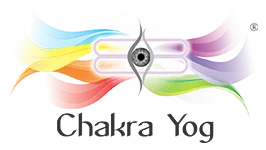Mudras for Ajna Chakra
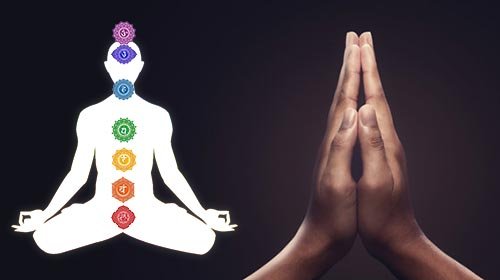
‘Mudra’ is a Sanskrit term that translates to ‘hand gesture.’ Mudras are precise hand gestures designed to improve the flow of energy, Prana, in the body and mind. Mudras have been used since ancient times to express deeper significance in several Hindu and Buddhist ceremonies and traditional dance forms. Mudras are part of the yogic and Vedic healing practice and they continue being practiced nowadays in yoga. When we hear the term yoga, we usually think in yoga asanas and breathing patterns or pranayama, however in any yoga practice yoga mudras or hand gestures are combined, being Namaste the most common and popular.

The term “mudra” is derived from the Sanskrit terms muda and dra, which mean “bliss dissolving,” and denotes to that which dissolves dualism and brings the Yogi and the Divine together.
Yoga Mudra is the technique that works by modifying or diverting energy flow throughout the body through hand movements along acupuncture meridians, putting our energy body into perfect harmony or balance. Because the hands contain all of the acupuncture meridians, they are regarded as the body’s control panel. The five fingers of a hand symbolize the five elements of the body, known as Pancha Mahabhutas, which are fire, water, air, sky, and earth. According to Ayurveda, these energies must be in balance for the body to be at its best health and balance.
When we place our fingers and hands in a specific way, whether we bend, press, cross, extend, or touch our fingers with the other fingers, we are actually altering the energy flow, prana, through these acupuncture points, which influences and stimulates specific areas of the brain and aids in the restoration of elemental balance in the body.
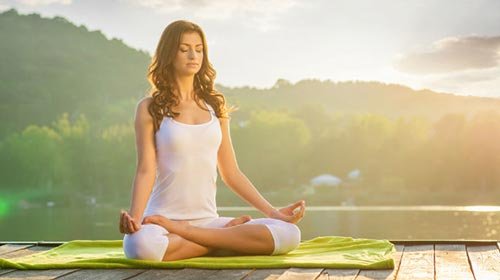
Mudras are practiced along with meditation and breathing techniques to direct the flow of energy throughout the body. It takes some time to become sensitive to the effects of these mudras. To begin, sit in a comfortable meditation posture such as Sukhasana (easy pose), Vajrasana (diamond pose), or Padmasana (lotus pose).
If you don’t feel comfortable sitting on the floor, you may sit on a chair with your back straight. It is critical to warm up your hands before executing these mudras in order to feel the feelings.
It is best to sit in a peaceful and quiet environment that is devoid of distractions. Keeping the eyes closed boosts the healing potential and allows you to observe the feelings that grow inside during the practice.
- The first step is to massage your hands together for 20 to 30 seconds to stimulate circulation. The friction will cause warmth to rise from your hands, indicating that all of the nerve endings in your hands have been activated, and thus, activating each cell associated to numerous organs.
- Place your hands on your lap, and your palms facing up; attempt to calm your mind in the serenity and silence of nature to experience the tingling or pulsing feelings in your hands and body. Uphold this posture for at least 15 seconds.
- Then, with your fingers pressed in certain patterns, execute different mudras, and apply enough pressure to feel the energy flow. Gentleness is key; little is more when it comes to mudras. Remember that you cannot damage yourself if you make a mistake, so you can relax and proceed.
Our energy body governs our physical body to a large degree. Disorders develop as a result of an imbalance in energy in the different organs and their related chakras; mudras may assist balance these energy levels and prana. Yoga mudras even when looking simple, they may be a very effective therapeutic tool.
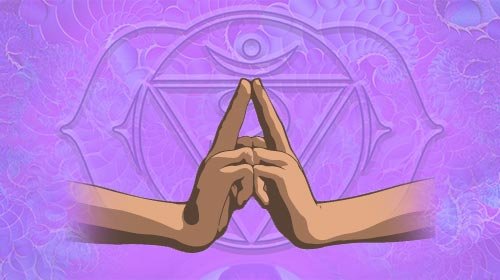
Mudras for Ajna chakra increase mental clarity and confidence in your intuition, allowing you to properly notice events in your life and the lessons they teach you. You will then be able to detect the subtle energy that produces and connects everything in the universe. You will be able to sense things as they really are without the ego’s projection and awake the Ajna chakra. From there, you may be able to move more successfully toward the things in life that you value.
Below are some of the most practiced and effective Mudras for Ajna. It is important to note that these are the stone foundation mudras for Ajna from which ones many variations of mudras developed into other similar gestures, just in the same way yoga asanas are practiced in multiple variations too.
Shambhavi Mudra
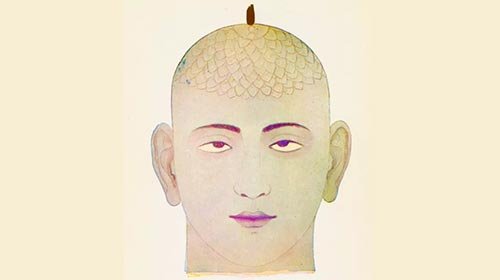
Shambhavi Mudra is a well-known yogic and tantric practice mentioned in the Gheranda Samhita. Shambhavi is a strong mudra used during meditation to calm the mind and access higher levels of consciousness. It entails focusing on the middle of the brow. It is also known as the eyebrow center gazing gesture.
Shambhavi mudra is hold as one of the most important mudras for meditation and activates the Third Eye chakra effortlessly and naturally . The eyes are in direct contact with our minds. When the eyes move, the mind becomes more engaged. However, when you focus your gaze on one point, your mind slows down and your thoughts become more controllable.
Procedure: The fingers may be in Jnana mudra or Chin mudra, with the palms resting on the knees. Shambhavi mudra is just looking at the middle of the brow. We can’t see the point where the two brows meet with our eyes. However, an effort is made to concentrate vision between the brows. Roll both eyes upwards and attempt to focus on the brow center. When you do this, the two brows will appear as two curved lines intersecting in the middle. It produces a V-shaped line with a dip in the middle. Pay attention to the dip in the bottom center section of the V-shaped line. Keep this posture for as long as possible. Relax the eyes and return them to their regular posture. Allow some time to pass before attempting again. With practice, this stare may be maintained for a longer amount of time.
Hakini Mudra
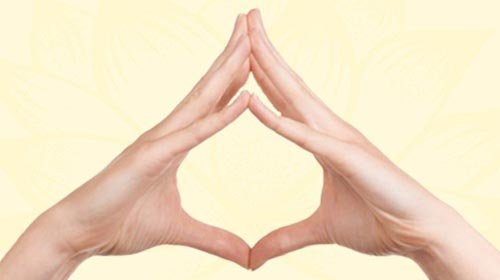
Hakini Mudra is the mudra of the goddess Hakini, who personifies the energy of the third eye’s Ajna chakra. This mudra is called after Shakti, divine feminine and consort of Lord Shiva who embodies the creative force of the universe. In science, this hand posture encourages the interconnection of the left and right cerebral hemispheres. Because of its effectiveness, this mudra is used to educate in modern-day management programs and memory training sessions.
Hakini mudra is a powerful tool for increasing intuition, activating your Third Eye, and assisting you in making sound judgments.
Procedure: This is a simple mudra that requires just connecting the tips of all fingers. You will touch and hold the tips of your thumb, index, middle, ring, and little finger in both hands. Hold on as much as you feel the need to keep it.
Kali Mudra
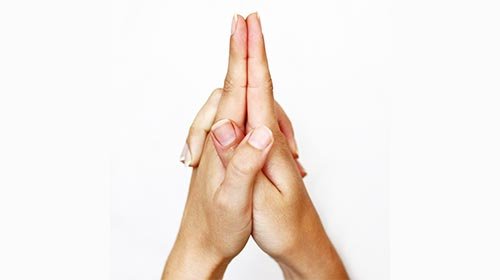
Kali Mudra has the power of the goddess after whom it is called, Goddess Kali. She is regarded as one of Shakti’s most powerful manifestations. It gives the skill to letting go. Kali mudra reinforces good thinking while eliminating emotions of annoyance, stress, tension, diversions, anger, and aggravation.
Kali mudra expels any negative energy from the energy pathways. The Kali Mudra is also referred to as the Ksepana Mudra and the Maha Kali Mudra.
Procedure: Bring your hands in front of your face and unite them in the Anjali Mudra. Interlock all of the fingers save the index fingers. Your left and right thumbs will be crossed. Point your hands towards the ground, index fingers joint and straight. You may beckon the grace of Goddess Kali and pray for her protection and guidance by chanting the mantra ‘Om Krim Kali Namaha.’ Spend at least 15 minutes meditating with this mudra.
Gyan Mudra
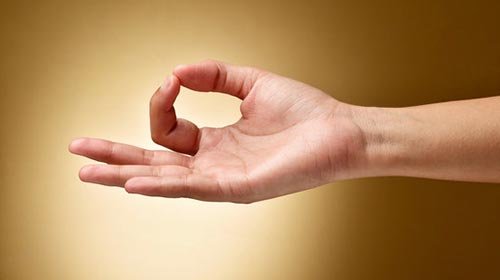
Gyan Mudra redirects energy to Ajna chakra, improving mental concentration and attention. By linking the thumb and second finger, it also activates the air and fire elements. This stimulates the neurological system, the endocrine system, and the pituitary gland. It is one of the most well-known and widely utilized meditation mudras in numerous spiritual traditions, and it is relatively simple to do.
Procedure: Keep a straight back. If you have difficulty sitting with your back straight, you may rest it against a wall. Maintain a straight and steady head. Close your eyes and make no movements with your eyelids. Form a consistent circle using the top portion of the thumb and the upper part of the index finger while keeping the rest of the fingers upright. Place your palms on your knees, facing up. Remove all ideas from your mind and concentrate just on OM. It should also be done with both hands at the same time. Concentrate on your breathing. Fill your lungs with air and gently exhale. Do not speed up or slow down your breathing. Shift your focus to the third eye chakra gradually.
As we have seen practicing yoga mudras regularly is surprisingly effective by just using our hands and blending the brief practice with a quiet environment, the exercise of pranayama (breathing techniques) and chanting and focusing on the beej sound OM. Doing it regularly is a perfect starting point to get our Third Eye (Ajna) Chakra balanced and move forward to more advanced or alternative healing methods in this direction.


